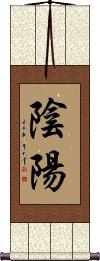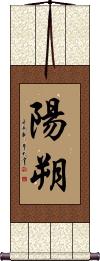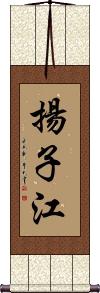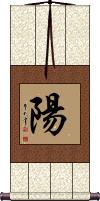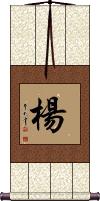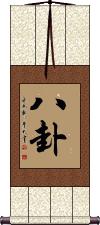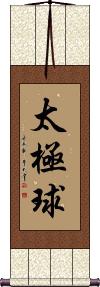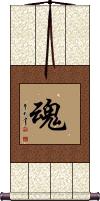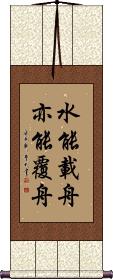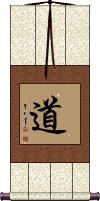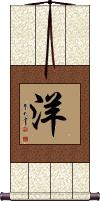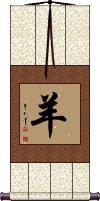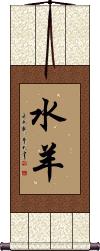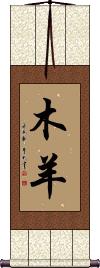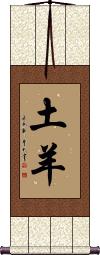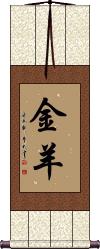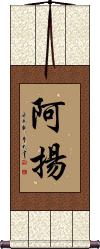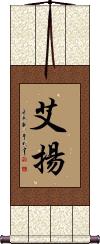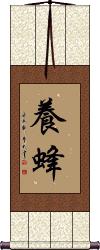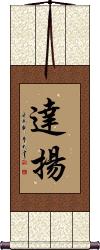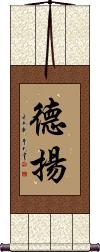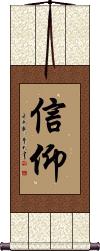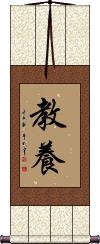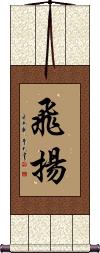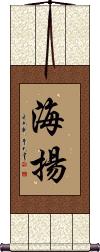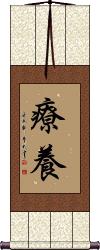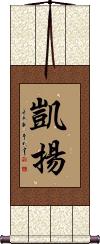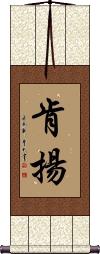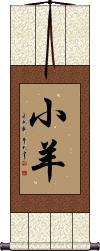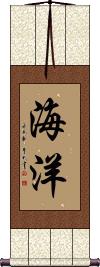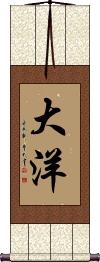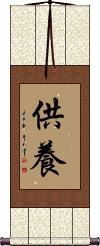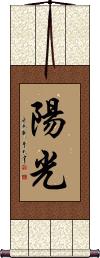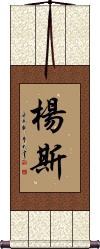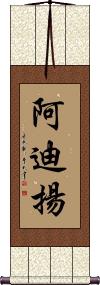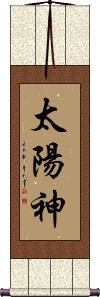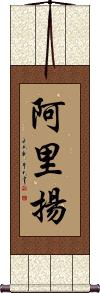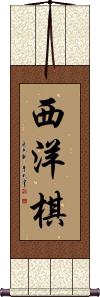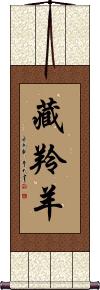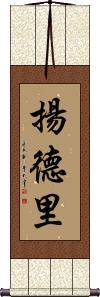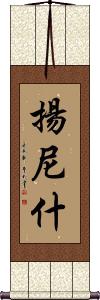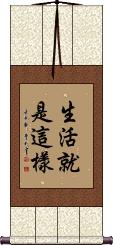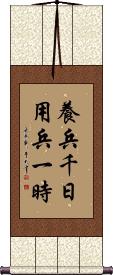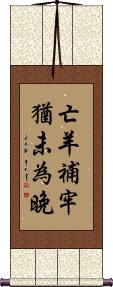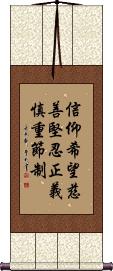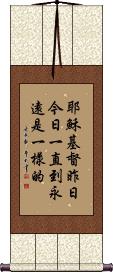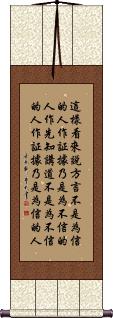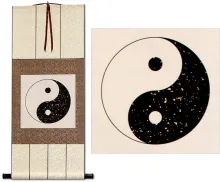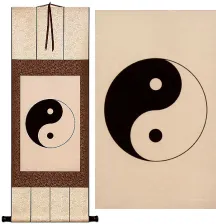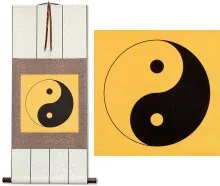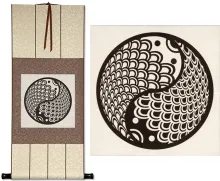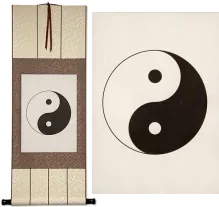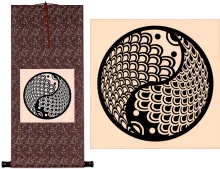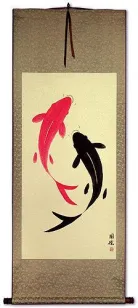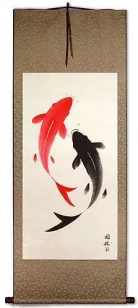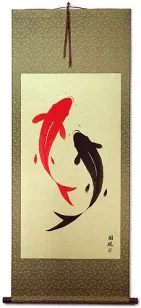Many custom options...
And formats...

Yang in Chinese / Japanese...
Buy a Yang calligraphy wall scroll here!
Personalize your custom “Yang” project by clicking the button next to your favorite “Yang” title below...
1. Yin Yang
2. Yangshuo
5. Yeoh
6. Ba Gua
7. Tai Chi Ball
10. Not Only Can Water Float A Boat, It Can Sink It Also
11. Daoism / Taoism
12. Ocean
13. Goat / Sheep
14. Water Goat/Sheep
15. Wood Goat/Sheep
16. Fire Goat/Sheep
17. Earth Goat/Sheep
19. Ayann
20. Ayyan
22. Dayan
23. Dejan
24. Religious Devotion / Faith in God / Religious Faith
26. Flying / Flight / Rising Upward
27. Hayyan
28. To Heal
29. Kaijan
30. Kenyon
31. Lamb
32. Layan
33. Ocean
34. Great Sea
35. Offering / Puja
36. Rayaan
37. Self-Improvement
38. Sunshine
39. Yance
40. Yancey
41. Yancy
42. Yanna
43. Yonkin
44. Sujan
45. Yandy
46. Adiyan
47. Apollo
48. Ariyan
49. Chess
51. Ilijan
52. Oceania
53. Yambol
54. Yanderi
55. Yannish
56. Aries
57. Capricorn
58. Jayanth
59. Aliyan
60. Be Like Water
61. Buyanzaya
62. Preangka
63. Priyanjan
64. Suryansh
65. Tatyana
66. Vinayanti
67. CIA
68. Such is Life
69. Maintain An Army For 1000 Days, Use It For An Hour
72. Hebrews 13:8
Yin Yang
陰陽 literally means yin and yang in written form (versus the common yin-yang symbol). The first character has the element of the moon, while the second character has the element of the sun so that you can see, even in written form, they suggest the balance of opposites (of night and day). You could also translate this title as “sun and moon.”
Note: This title is often misspelled as Ying Yang instead of Yin Yang.
See Also: Taoism
Yangshuo
Yangtze River
Yako / Minami
This can be the Japanese surname Yako or Minami.
陽 is actually the yang from yin and yang ☯.
The meaning includes positive, sun, male, the side on which the sun shines, the sun, heat, masculine, dynamic, etc.
Yeoh
Ba Gua
Tai Chi Ball
Soul / Spirit
魂 means soul or spirit as in the immortal soul that can be detached from the body.
This can also refer to one's Yang energy or spirit.
In the Buddhist context, this can be the soul, conscious mind, or vijñāna.
Broken Mirror Rejoined
Used in modern times for divorced couples that come back together
破鏡重圓 is about a husband and wife who were separated and reunited.
About 1500 years ago in China, there lived a beautiful princess named Le Chang. She and her husband Xu De Yan loved each other very much. But when the army of the Sui Dynasty was about to attack their kingdom, disposed of all of their worldly possessions and prepared to flee into exile.
They knew that in the chaos, they might lose track of each other, so the one possession they kept was a bronze mirror which is a symbol of unity for a husband and wife. They broke the mirror into two pieces, and each of them kept half of the mirror. They decided that if separated, they would try to meet at the fair during the 15th day of the first lunar month (which is the lantern festival). Unfortunately, the occupation was brutal, and the princess was forced to become the mistress of the new commissioner of the territory, Yang Su.
At the Lantern Festival the next year, the husband came to the fair to search for his wife. He carried with him his half of the mirror. As he walked through the fair, he saw the other half of the mirror for sale at a junk market by a servant of the commissioner. The husband recognized his wife's half of the mirror immediately, and tears rolled down his face as he was told by the servant about the bitter and loveless life that the princess had endured.
As his tears dripped onto the mirror, the husband scratched a poem into his wife's half of the mirror:
You left me with the severed mirror,
The mirror has returned, but absent are you,
As I gaze in the mirror, I seek your face,
I see the moon, but as for you, I see not a trace.
The servant brought the inscribed half of the mirror back to the princess. For many days, the princess could not stop crying when she found that her husband was alive and still loved her.
Commissioner Yang Su, becoming aware of this saga, realized that he could never obtain the princess's love. He sent for the husband and allowed them to reunite.
This proverb, 破鏡重圓, is now used to describe a couple who has been torn apart for some reason (usually divorce) but have come back together (or remarried).
It seems to be more common these days in America for divorced couples to reconcile and get married to each other again. This will be a great gift if you know someone who is about to remarry their ex.
Not Only Can Water Float A Boat, It Can Sink It Also
Many things have opposite properties. The water you drink can also drown you. Pork may nourish you and keep you alive but under-cook it and it could kill you. Potassium nitrate is often used as a fertilizer to grow the food that sustains us but it's also been used as an explosive to topple buildings and destroy us.
This concept is easily associated with “yin yang” where an element has two opposite properties that are as different as night and day.
This proverb's meaning can be summed up this way: “Anything that can lead you to success may also contain great risks.”
This phrase is known in literary circles by Korean people (scholars or literature). It is therefore also a valid proverb in Korean Hanja, though most Koreans would not be able to make sense of it.
Please note that there is an unwritten rule when the same character appears twice in the same phrase, the calligrapher will alter the appearance so that no two characters are exactly alike in the same piece. This calligraphy has two repeating characters that will be written differently than they appear here.
Daoism / Taoism
Literally: The Way or Road
道 is the character “dao” which is sometimes written as “tao” but pronounced like “dow” in Mandarin.
道 is the base of what is known as “Taoism.” If you translate this literally, it can mean “the way” or “the path.”
Dao is believed to be that which flows through all things and keeps them in balance. It incorporates the ideas of yin and yang (e.g. there would be no love without hate, no light without dark, no male without female.)
The beginning of Taoism can be traced to a mystical man named
Lao Zi (604-531 BC), who followed, and added to the teachings of Confucius.
More about Taoism / Daoism here.
Note that this is pronounced “dou” and sometimes “michi” when written alone in Japanese but pronounced “do” in word compounds such as Karate-do and Bushido. It's also “do” in Korean.
Alternate translations and meanings: road, way, path; truth, principle province.
Important Japanese note: In Japanese, this will generally be read with the road, way, or path meaning. Taoism is not as popular or well-known in Japan so Daoist/Taoist philosophy is not the first thing a Japanese person will think of when they read this character.
See our Taoism Page
Ocean
This is the Chinese and old Korean Hanja word for ocean. This can be pronounced in Japanese, and has the same meaning but is rarely seen alone in Japanese.
Besides ocean or sea, this character can also mean foreign, wide, or vast.
It's more common for Chinese people to use a different word “hai” for ocean or sea.
Goat / Sheep
Year of the Goat / Zodiac Sign
羊 is the character for goat or sheep in Chinese, old Korean, and Japanese.
If you were born in the year of the goat (sheep), you . . .
Are sophisticated and considerate
Can always find the best solution to problems.
Are tolerant.
Are not afraid of hardship.
Know how to save money (thrifty).
See also our Chinese Zodiac page.
Water Goat/Sheep
The Year of the Water Goat/Sheep
水羊 is Water Goat/Sheep in Chinese.
In the Chinese zodiac and sexagenary (60-year) cycle, this combination occurs in years that include 1883, 1943, 2003, and 2063.
In the sexagenary cycle, this year is represented by 癸未.
See Also: Goat/Sheep
Wood Goat/Sheep
The Year of the Wood Goat/Sheep
木羊 is Wood Goat/Sheep in Chinese.
In the Chinese zodiac and sexagenary (60-year) cycle, this combination occurs in years that include 1895, 1955, 2015, and 2075.
In the sexagenary cycle, this year is represented by 乙未.
See Also: Goat/Sheep
Fire Goat/Sheep
The Year of the Fire Goat/Sheep
火羊 is Fire Goat/Sheep in Chinese.
In the Chinese zodiac and sexagenary (60-year) cycle, this combination occurs in years that include 1907, 1967, 2027, and 2087.
In the sexagenary cycle, this year is represented by 丁未.
See Also: Goat/Sheep
Earth Goat/Sheep
The Year of the Earth Goat/Sheep
土羊 is Earth Goat/Sheep in Chinese.
In the Chinese zodiac and sexagenary (60-year) cycle, this combination occurs in years that include 1919, 1979, 2039, and 2099.
In the sexagenary cycle, this year is represented by 己未.
See Also: Goat/Sheep
Golden/Metal Goat/Sheep
The Year of the Golden/Metal Goat/Sheep
金羊 is Golden/Metal Goat/Sheep in Chinese.
In the Chinese zodiac and sexagenary (60-year) cycle, this combination occurs in years that include 1871, 1931, 1991, and 2051.
In the sexagenary cycle, this year is represented by 辛未.
See Also: Goat/Sheep
Ayann
Ayyan
Beekeeping / Apiculture
養蜂 is the Chinese, Japanese, and Korean title for beekeeping, to raise bees or apiculture.
A nice gift for an avid beekeeper.
Dayan
Dejan
Religious Devotion / Faith in God / Religious Faith
信仰 means firm belief, faith, persuasion, conviction, and sometimes religion or creed in Chinese, Japanese Kanji, and old Korean Hanja.
This clearly fits the religious connotation of the English word “devotion.”
This is often used to refer to a person of faith or a religious person.
This can be directly translated as “firm belief,” “creed,” “conviction,” or simply as “religious,” depending on context.
Some will also use this to mean “trust in God” in Japanese (though the term for God is not actually in this title).
It should be noted that this word is a little strange alone on a wall scroll.
While this can be pronounced in Japanese, it’s not a great selection for a wall scroll if your audience is Japanese.
See Also: Faith | Trust | Devotion | Trust | Trust in God
Education / Refinement
Flying / Flight / Rising Upward
Hayyan
To Heal
療養 is “to heal” in Chinese, Japanese Kanji, and old Korean Hanja.
This can also be translated as to get well, to recuperate, to convalesce, convalescence, recuperation, and in certain contexts, medical treatment or to nurse.
Kaijan
Kenyon
Lamb
Layan
Ocean
海洋 is probably the most common word for “ocean” in Japanese. 海洋 is also sometimes used in Chinese and Korean Hanja.
In Japan, this can also be a female given name when pronounced as Miyou or Unami.
Great Sea
This is a rarely-used word for ocean in Japanese, Chinese, and Korean. This is here mostly for reference - please order a different ocean for your custom calligraphy wall scroll.
The first character means “big” or “great.”
The second means “ocean” or “body of water” (it can sometimes mean “foreign” but not in this case).
The first character designates that you are talking about a great or huge body of water (certainly a major ocean and not a smaller sea).
Offering / Puja
供養 is the Chinese, Japanese, and Korean rough equivalent to the Sanskrit word, Pūjā.
The meaning is: To make offerings (to the Gods), to supply, to provide for one's elders, to support one's parents, a memorial service for the dead, holding a service, any offering for body or mind, to make offerings of whatever nourishes (e.g., food, goods, incense, lamps, scriptures, the doctrine).
The final meaning varies greatly depending on the context in which the word is used.
Rayaan
Self-Improvement
修養 means self-improvement in Chinese, Japanese Kanji, and old Korean Hanja.
Other translations for this word include accomplishment, training, self-cultivation, (mental) training, self-discipline, cultivation, or cultivating moral character.
Sunshine
陽光 is the Chinese word for sunshine.
陽光 is a more emotional word compared to another Asian word that means “sunlight.” If you were going to sing a song or write a poem, this is the word you would use.
Note: This is a rarely-used word in Korean or Japanese.
Yance
Yancey
Yancy
Yanna
Yonkin
Sujan
Yandy
Adiyan
Apollo
太陽神 means “Sun God” in Chinese, Japanese, and Korean.
It's used in Chinese to mean the Greek God Apollo. This can also be used in Chinese to refer to Nasa's Apollo missions to the moon.
Ariyan
Chess
Tibetan antelope / Chiru
Ilijan
Oceania
Yambol
Yanderi
Yannish
Aries Zodiac Symbol / Sign
牡羊座 is the Chinese and Japanese way to write Aries (ram) of western astrology.
See Also: Chinese Zodiac
Aries Zodiac Symbol / Sign
(Alternate / Chinese)
白羊座 is an alternate Chinese way to write Aries (ram) from western astrology.
I don't believe it is used at all in Japanese, so the other version is probably better or at least more universal.
See Also: Chinese Zodiac
Capricorn Zodiac Symbol / Sign
山羊座 is the Chinese and Japanese way to write Capricorn (horned goat) from western astrology.
See Also: Chinese Zodiac
Jayanth
Aliyan
Be Like Water
像水一樣 is a short quote from a much longer statement by Bruce Lee.
He summarized how people should be flexible to all circumstances, attacks, or situations. In the end, he exclaims, “Be like water, my friend.” 像水一樣 is the “Be like water” part alone since that seems to be what most people want.
Buyanzaya
Preangka
Priyanjan
Suryansh
Tatyana
Vinayanti
Such is Life
Nothing could be more true. When I was in the Marine Corps, we trained for years for combat that often lasts only hours.
養兵千日用兵一時 is a Chinese proverb that, also reminds me of a common phrase used in the military to describe combat: “Weeks of total boredom, punctuated with five minutes of sheer terror.”
This may have some roots in Sun Tzu's The Art of War. Though I can not find this passage in his writings.
On the subject of the Art of War, if you have a favorite passage, we can create a custom calligraphy scroll with that phrase.
Better Late Than Never
It's Never Too Late Too Mend
Long ago in what is now China, there were many kingdoms throughout the land. This time period is known as “The Warring States Period” by historians because these kingdoms often did not get along with each other.
Sometime around 279 B.C. the Kingdom of Chu was a large but not particularly powerful kingdom. Part of the reason it lacked power was the fact that the King was surrounded by “yes men” who told him only what he wanted to hear. Many of the King's court officials were corrupt and incompetent which did not help the situation.
The King was not blameless himself, as he started spending much of his time being entertained by his many concubines.
One of the King's ministers, Zhuang Xin, saw problems on the horizon for the Kingdom, and warned the King, “Your Majesty, you are surrounded by people who tell you what you want to hear. They tell you things to make you happy and cause you to ignore important state affairs. If this is allowed to continue, the Kingdom of Chu will surely perish, and fall into ruins.”
This enraged the King who scolded Zhuang Xin for insulting the country and accused him of trying to create resentment among the people. Zhuang Xin explained, “I dare not curse the Kingdom of Chu but I feel that we face great danger in the future because of the current situation.” The King was simply not impressed with Zhuang Xin's words.
Seeing the King's displeasure with him and the King's fondness for his court of corrupt officials, Zhuang Xin asked permission from the King that he may take leave of the Kingdom of Chu, and travel to the State of Zhao to live. The King agreed, and Zhuang Xin left the Kingdom of Chu, perhaps forever.
Five months later, troops from the neighboring Kingdom of Qin invaded Chu, taking a huge tract of land. The King of Chu went into exile, and it appeared that soon, the Kingdom of Chu would no longer exist.
The King of Chu remembered the words of Zhuang Xin and sent some of his men to find him. Immediately, Zhuang Xin returned to meet the King. The first question asked by the King was “What can I do now?”
Zhuang Xin told the King this story:
A shepherd woke one morning to find a sheep missing. Looking at the pen saw a hole in the fence where a wolf had come through to steal one of his sheep. His friends told him that he had best fix the hole at once. But the Shepherd thought since the sheep is already gone, there is no use fixing the hole.
The next morning, another sheep was missing. And the Shepherd realized that he must mend the fence at once. Zhuang Xin then went on to make suggestions about what could be done to reclaim the land lost to the Kingdom of Qin, and reclaim the former glory and integrity of the Kingdom of Chu.
The Chinese idiom shown above came from this reply from Zhuang Xin to the King of Chu almost 2,300 years ago.
It translates roughly into English as...
“Even if you have lost some sheep, it's never too late to mend the fence.”
This proverb, 亡羊补牢犹未为晚, is often used in modern China when suggesting in a hopeful way that someone change their ways, or fix something in their life. It might be used to suggest fixing a marriage, quitting smoking, or getting back on track after taking an unfortunate path in life among other things one might fix in their life.
I suppose in the same way that we might say, “Today is the first day of the rest of your life” in our western cultures to suggest that you can always start anew.
Note: This does have Korean pronunciation but is not a well-known proverb in Korean (only Koreans familiar with ancient Chinese history would know it). Best if your audience is Chinese.
Seven Heavenly Virtues
信仰希望慈善堅忍正義慎重節制 is a list in Chinese and Japanese Kanji of an interpretation of the Seven Heavenly Virtues.
1. Faith is belief in God, and the right virtues.
2. Hope is taking a positive future view that good will prevail.
3. Charity is a concern for, and active helping of, others.
4. Fortitude is never giving up.
5. Justice is being fair and equitable with others.
6. Prudence is care of and moderation with money.
7. Temperance is moderation of needed things and abstinence from things that are not needed.
The full list is here. 信仰希望慈善堅忍正義慎重節制 is a word list, not a common phrase. While all Chinese and Japanese people will recognize the words in the list, they may not understand what the list is about (unless they are familiar with the Seven Heavenly Virtues).
don’t get this as a tattoo or anything like that without first consulting a native translator in the target language. These are fine for a wall scroll but a long discussion is needed before you commit to this for a lifetime inking commitment.
Hebrews 13:8
1 Corinthians 14:22
Here is 1 Corinthians 14:22 in Chinese.
The text with punctuation:
这样看来,说方言,不是为信的人作证据,乃是为不信的人。作先知讲道,不是为不信的人作证据,乃是为信的人。
Hand-painted calligraphy does not retain punctuation.
This translation is from the Chinese Union Bible.
You may know it from the KJV as:
Wherefore tongues are for a sign, not to them that believe, but to them that believe not: but prophesying serveth not for them that believe not, but for them which believe.
This in-stock artwork might be what you are looking for, and ships right away...
Not the results for yang that you were looking for?
Below are some entries from our dictionary that may match your yang search...
| Characters If shown, 2nd row is Simp. Chinese |
Pronunciation Romanization |
Simple Dictionary Definition |
楊 杨 see styles |
yáng yang2 yang zuon ズオン |
More info & calligraphy: Yeoh(1) willow (any tree of genus Salix); (2) weeping willow (Salix babylonica); (surname) Duong Willow; aspen, poplar, arbutus; syphilis. |
洋 see styles |
yáng yang2 yang you / yo よう |
More info & calligraphy: Ocean(1) Occident and Orient (esp. the Occident); (2) ocean; sea; (prefix) (3) foreign; Western; European; (personal name) Yōji |
羊 see styles |
yáng yang2 yang hitsuji(p); hitsuji ひつじ(P); ヒツジ |
More info & calligraphy: Goat / Sheepsheep (Ovis aries); (female given name) Yō avi, a sheep, goat, ram. |
陽 阳 see styles |
yáng yang2 yang you / yo よう |
More info & calligraphy: Yako / Minami(noun - becomes adjective with の) (1) (the) positive; (2) (ant: 陰・2) yang (in Chinese divination); (3) (See 陰に陽に) the open; visible place; public place; (personal name) Yōji The side on which the sun shines, the sun, heat, this life, positive, masculine, dynamic, etc. |
供養 供养 see styles |
gòng yǎng gong4 yang3 kung yang kuyou / kuyo くよう |
More info & calligraphy: Offering / Puja(noun, transitive verb) memorial service for the dead; holding a service To make offerings of whatever nourishes, e. g. food, goods, incense, lamps, scriptures, the doctrine, etc., any offering for body or mind. |
信仰 see styles |
xìn yǎng xin4 yang3 hsin yang shinkou / shinko しんこう |
More info & calligraphy: Religious Devotion / Faith in God / Religious Faith(noun, transitive verb) (religious) faith; belief; creed; (given name) Shinkou To believe in and look up to. |
修養 修养 see styles |
xiū yǎng xiu1 yang3 hsiu yang shuuyou / shuyo しゅうよう |
More info & calligraphy: Self-Improvement(n,vs,vi) self-improvement; (mental) training; self-discipline; cultivation cultivating moral character |
大洋 see styles |
dà yáng da4 yang2 ta yang taiyou / taiyo たいよう |
More info & calligraphy: Great Sea(noun - becomes adjective with の) ocean; (personal name) Motohiro |
太陽 太阳 see styles |
tài yang tai4 yang5 t`ai yang tai yang taiyou / taiyo たいよう |
More info & calligraphy: SunSun; (female given name) Minami |
小羊 see styles |
xiǎo yáng xiao3 yang2 hsiao yang kohitsuji こひつじ |
More info & calligraphy: Lamblamb |
教養 教养 see styles |
jiào yǎng jiao4 yang3 chiao yang kyouyou / kyoyo きょうよう |
More info & calligraphy: Education / Refinement(understanding or appreciation of) culture; (one's) education; cultivation; sophistication; refinement |
海洋 see styles |
hǎi yáng hai3 yang2 hai yang kaiyou / kaiyo かいよう |
More info & calligraphy: Oceanocean; sea; (female given name) Miyou |
療養 疗养 see styles |
liáo yǎng liao2 yang3 liao yang ryouyou / ryoyo りょうよう |
More info & calligraphy: To Heal(n,vs,vi) recuperation; medical treatment |
陰陽 阴阳 see styles |
yīn yáng yin1 yang2 yin yang inyou(p); onmyou; onyou / inyo(p); onmyo; onyo いんよう(P); おんみょう; おんよう |
More info & calligraphy: Yin Yangcosmic dual forces; yin and yang; sun and moon, etc.; (place-name) In'you yin and yang |
陽光 阳光 see styles |
yáng guāng yang2 guang1 yang kuang youkou / yoko ようこう |
More info & calligraphy: Sunshinesunshine; sunlight; (female given name) Yōkou The sun's light, also idem陽燄 sun flames, or heat, i.e. the mirage causing the illusion of lakes. |
陽朔 阳朔 see styles |
yáng shuò yang2 shuo4 yang shuo |
More info & calligraphy: Yangshuo |
飛揚 飞扬 see styles |
fēi yáng fei1 yang2 fei yang hiyou / hiyo ひよう |
More info & calligraphy: Flying / Flight / Rising Upward(n,vs,vi) flying; flight; (personal name) Hiyou |
養蜂 养蜂 see styles |
yǎng fēng yang3 feng1 yang feng youhou / yoho ようほう |
More info & calligraphy: Beekeeping / Apiculture(noun - becomes adjective with の) beekeeping; apiculture |
大洋洲 see styles |
dà yáng zhōu da4 yang2 zhou1 ta yang chou |
More info & calligraphy: Oceania |
太陽神 太阳神 see styles |
tài yáng shén tai4 yang2 shen2 t`ai yang shen tai yang shen taiyoushin / taiyoshin たいようしん |
More info & calligraphy: Apollosun god |
山羊座 see styles |
shān yáng zuò shan1 yang2 zuo4 shan yang tso yagiza やぎざ |
More info & calligraphy: Capricorn Zodiac Symbol / SignCapricornus (constellation); Capricorn; the Goat |
揚子江 扬子江 see styles |
yáng zǐ jiāng yang2 zi3 jiang1 yang tzu chiang yousukou / yosuko ようすこう |
More info & calligraphy: Yangtze River(See 長江) Yangtze River (China); (place-name) Yangtze River (China) |
牡羊座 see styles |
mǔ yáng zuò mu3 yang2 zuo4 mu yang tso ohitsujiza おひつじざ |
More info & calligraphy: Aries Zodiac Symbol / SignAries (constellation); the Ram |
白羊座 see styles |
bái yáng zuò bai2 yang2 zuo4 pai yang tso |
More info & calligraphy: Aries Zodiac Symbol / Sign |
藏羚羊 see styles |
zàng líng yáng zang4 ling2 yang2 tsang ling yang |
More info & calligraphy: Tibetan antelope / Chiru |
西洋棋 see styles |
xī yáng qí xi1 yang2 qi2 hsi yang ch`i hsi yang chi |
More info & calligraphy: Chess |
仰 see styles |
yǎng yang3 yang takashi たかし |
to face upward; to look up; to admire; to rely on (given name) Takashi Look up, respectful; lying with the face upward, opposite of 俯; translit. n as in aṅga, cf. 我, 俄 哦. |
佯 see styles |
yáng yang2 yang |
to feign; to pretend |
坱 see styles |
yǎng yang3 yang |
fine dust; plentiful; vast |
垟 see styles |
yáng yang2 yang |
clay sheep buried with the dead |
Click here for more yang results from our dictionary
The following table may be helpful for those studying Chinese or Japanese...
| Title | Characters | Romaji (Romanized Japanese) | Various forms of Romanized Chinese | |
| Yin Yang | 陰陽 阴阳 | in you / inyou / in yo | yīn yáng / yin1 yang2 / yin yang / yinyang | |
| Yangshuo | 陽朔 阳朔 | yáng shuò yang2 shuo4 yang shuo yangshuo | ||
| Yangtze River | 揚子江 扬子江 | you su kou / yousukou / yo su ko | yáng zǐ jiāng yang2 zi3 jiang1 yang zi jiang yangzijiang | yang tzu chiang yangtzuchiang |
| Yako Minami | 陽 阳 | you / yo | yáng / yang2 / yang | |
| Yeoh | 楊 杨 | yáng / yang2 / yang | ||
| Ba Gua | 八卦 | bā guà / ba1 gua4 / ba gua / bagua | pa kua / pakua | |
| Tai Chi Ball | 太極球 太极球 | tai kyoku kyuu taikyokukyuu tai kyoku kyu | tài jí qiú tai4 ji2 qiu2 tai ji qiu taijiqiu | t`ai chi ch`iu taichichiu tai chi chiu |
| Soul Spirit | 魂 | tamashi / kon | hún / hun2 / hun | |
| Broken Mirror Rejoined | 破鏡重圓 破镜重圆 | pò jìng chóng yuán po4 jing4 chong2 yuan2 po jing chong yuan pojingchongyuan | p`o ching ch`ung yüan pochingchungyüan po ching chung yüan |
|
| Not Only Can Water Float A Boat, It Can Sink It Also | 水能載舟亦能覆舟 水能载舟亦能覆舟 | shuǐ néng zài zhōu yì néng fù zhōu shui3 neng2 zai4 zhou1 yi4 neng2 fu4 zhou1 shui neng zai zhou yi neng fu zhou | shui neng tsai chou i neng fu chou | |
| Daoism Taoism | 道 | michi / -do | dào / dao4 / dao | tao |
| Ocean | 洋 | you / yo | yáng / yang2 / yang | |
| Goat Sheep | 羊 | hitsuji | yáng / yang2 / yang | |
| Water Goat/Sheep | 水羊 | shuǐ yáng shui3 yang2 shui yang shuiyang | ||
| Wood Goat/Sheep | 木羊 | mù yáng / mu4 yang2 / mu yang / muyang | ||
| Fire Goat/Sheep | 火羊 | huǒ yáng / huo3 yang2 / huo yang / huoyang | ||
| Earth Goat/Sheep | 土羊 | tǔ yáng / tu3 yang2 / tu yang / tuyang | t`u yang / tuyang / tu yang | |
| Golden/Metal Goat/Sheep | 金羊 | jīn yáng / jin1 yang2 / jin yang / jinyang | chin yang / chinyang | |
| Ayann | 阿揚 阿扬 | ā yáng / a1 yang2 / a yang / ayang | ||
| Ayyan | 艾揚 艾扬 | ài yáng / ai4 yang2 / ai yang / aiyang | ||
| Beekeeping Apiculture | 養蜂 养蜂 | youhou / yoho | yǎng fēng yang3 feng1 yang feng yangfeng | |
| Dayan | 達揚 达扬 | dá yáng / da2 yang2 / da yang / dayang | ta yang / tayang | |
| Dejan | 德揚 德扬 | dé yáng / de2 yang2 / de yang / deyang | te yang / teyang | |
| Religious Devotion Faith in God Religious Faith | 信仰 | shin kou / shinkou / shin ko | xìn yǎng / xin4 yang3 / xin yang / xinyang | hsin yang / hsinyang |
| Education Refinement | 教養 教养 | kyou you / kyouyou / kyo yo | jiào yǎng jiao4 yang3 jiao yang jiaoyang | chiao yang chiaoyang |
| Flying Flight Rising Upward | 飛揚 飞扬 | hi you / hiyou / hi yo | fēi yáng / fei1 yang2 / fei yang / feiyang | |
| Hayyan | 海揚 海扬 | hǎi yáng / hai3 yang2 / hai yang / haiyang | ||
| To Heal | 療養 疗养 | ryou you / ryouyou / ryo yo | liáo yǎng liao2 yang3 liao yang liaoyang | |
| Kaijan | 凱揚 凯扬 | kǎi yáng / kai3 yang2 / kai yang / kaiyang | k`ai yang / kaiyang / kai yang | |
| Kenyon | 肯揚 肯扬 | kěn yáng / ken3 yang2 / ken yang / kenyang | k`en yang / kenyang / ken yang | |
| Lamb | 小羊 | kohitsuji | xiǎo yáng xiao3 yang2 xiao yang xiaoyang | hsiao yang hsiaoyang |
| Layan | 拉揚 拉扬 | lā yáng / la1 yang2 / la yang / layang | ||
| Ocean | 海洋 | kai you / kaiyou / kai yo | hǎi yáng / hai3 yang2 / hai yang / haiyang | |
| Great Sea | 大洋 | tai you / taiyou / tai yo | dà yáng / da4 yang2 / da yang / dayang | ta yang / tayang |
| Offering Puja | 供養 供养 | ku you / kuyou / ku yo | gòng yǎng gong4 yang3 gong yang gongyang | kung yang kungyang |
| Rayaan | 拉揚 拉扬 | lā yáng / la1 yang2 / la yang / layang | ||
| Self-Improvement | 修養 修养 | shuuyou / shuyo shuyo / shuyo | xiū yǎng / xiu1 yang3 / xiu yang / xiuyang | hsiu yang / hsiuyang |
| Sunshine | 陽光 阳光 | you kou / youkou / yo ko | yáng guāng yang2 guang1 yang guang yangguang | yang kuang yangkuang |
| Yance | 楊斯 杨斯 | yáng sī / yang2 si1 / yang si / yangsi | yang ssu / yangssu | |
| Yancey | 楊西 杨西 | yáng xī / yang2 xi1 / yang xi / yangxi | yang hsi / yanghsi | |
| Yancy | 楊西 杨西 | yáng xī / yang2 xi1 / yang xi / yangxi | yang hsi / yanghsi | |
| Yanna | 楊娜 杨娜 | yáng nà / yang2 na4 / yang na / yangna | ||
| Yonkin | 揚金 扬金 | yáng jīn / yang2 jin1 / yang jin / yangjin | yang chin / yangchin | |
| Sujan | 蘇揚 苏扬 | sū yáng / su1 yang2 / su yang / suyang | ||
| Yandy | 楊迪 杨迪 | yáng dí / yang2 di2 / yang di / yangdi | yang ti / yangti | |
| Adiyan | 阿迪揚 阿迪扬 | ā dí yáng a1 di2 yang2 a di yang adiyang | a ti yang atiyang |
|
| Apollo | 太陽神 太阳神 | taiyoushin / taiyoshin | tài yáng shén tai4 yang2 shen2 tai yang shen taiyangshen | t`ai yang shen taiyangshen tai yang shen |
| Ariyan | 阿里揚 阿里扬 | ā lǐ yáng a1 li3 yang2 a li yang aliyang | ||
| Chess | 西洋棋 | xī yáng qí xi1 yang2 qi2 xi yang qi xiyangqi | hsi yang ch`i hsiyangchi hsi yang chi |
|
| Tibetan antelope Chiru | 藏羚羊 | zàng líng yáng zang4 ling2 yang2 zang ling yang zanglingyang | tsang ling yang tsanglingyang |
|
| Ilijan | 伊利揚 伊利扬 | yī lì yáng yi1 li4 yang2 yi li yang yiliyang | i li yang iliyang |
|
| Oceania | 大洋洲 | dà yáng zhōu da4 yang2 zhou1 da yang zhou dayangzhou | ta yang chou tayangchou |
|
| Yambol | 揚博爾 扬博尔 | yáng bó ěr yang2 bo2 er3 yang bo er yangboer | yang po erh yangpoerh |
|
| Yanderi | 揚德里 扬德里 | yáng dé lǐ yang2 de2 li3 yang de li yangdeli | yang te li yangteli |
|
| Yannish | 揚尼什 扬尼什 | yáng ní shí yang2 ni1 shi2 yang ni shi yangnishi | yang ni shih yangnishih |
|
| Aries Zodiac Symbol Sign | 牡羊座 | ohitsuji-za | mù yáng zuò mu4 yang2 zuo4 mu yang zuo muyangzuo | mu yang tso muyangtso |
| Aries Zodiac Symbol Sign | 白羊座 | bái yáng zuò bai2 yang2 zuo4 bai yang zuo baiyangzuo | pai yang tso paiyangtso |
|
| Capricorn Zodiac Symbol Sign | 山羊座 | yagi-za | shān yáng zuò shan1 yang2 zuo4 shan yang zuo shanyangzuo | shan yang tso shanyangtso |
| Jayanth | 賈揚斯 贾扬斯 | jiǎ yáng sī jia3 yang2 si1 jia yang si jiayangsi | chia yang ssu chiayangssu |
|
| Aliyan | 阿里揚 阿里扬 | ā lǐ yáng a1 li3 yang2 a li yang aliyang | ||
| Be Like Water | 像水一樣 | xiàng shuǐ yí yàng xiang4 shui3 yi2 yang4 xiang shui yi yang xiangshuiyiyang | hsiang shui i yang hsiangshuiiyang |
|
| Buyanzaya | 布揚扎亞 布扬扎亚 | bù yáng zhā yà bu4 yang2 zha1 ya4 bu yang zha ya buyangzhaya | pu yang cha ya puyangchaya |
|
| Preangka | 普里揚卡 普里扬卡 | pǔ lǐ yáng kǎ pu3 li3 yang2 ka3 pu li yang ka puliyangka | p`u li yang k`a puliyangka pu li yang ka |
|
| Priyanjan | 普里揚詹 普里扬詹 | pǔ lǐ yáng zhān pu3 li3 yang2 zhan1 pu li yang zhan puliyangzhan | p`u li yang chan puliyangchan pu li yang chan |
|
| Suryansh | 蘇爾揚什 苏尔扬什 | sū ěr yáng shí su1 er3 yang2 shi2 su er yang shi sueryangshi | su erh yang shih suerhyangshih |
|
| Tatyana | 塔季揚娜 塔季扬娜 | tǎ jì yáng nà ta3 ji4 yang2 na4 ta ji yang na tajiyangna | t`a chi yang na tachiyangna ta chi yang na |
|
| Vinayanti | 維納揚蒂 维纳扬蒂 | wéi nà yáng dì wei2 na4 yang2 di4 wei na yang di weinayangdi | wei na yang ti weinayangti |
|
| CIA | 中央情報局 中央情报局 | chuuoujouhoukyoku / chuojohokyoku chuojohokyoku / chuojohokyoku | zhōng yāng qíng bào jú zhong1 yang1 qing2 bao4 ju2 zhong yang qing bao ju zhongyangqingbaoju | chung yang ch`ing pao chü chungyangchingpaochü chung yang ching pao chü |
| Such is Life | 生活就是這樣 生活就是这样 | shēng huó jiù shì zhè yàng sheng1 huo2 jiu4 shi4 zhe4 yang4 sheng huo jiu shi zhe yang shenghuojiushizheyang | sheng huo chiu shih che yang shenghuochiushihcheyang |
|
| Maintain An Army For 1000 Days, Use It For An Hour | 養兵千日用兵一時 养兵千日用兵一时 | yǎng bīng qiān rì, yàng bīng yì shí yang3 bing1 qian1 ri4 yang4 bing1 yi4 shi2 yang bing qian ri yang bing yi shi | yang ping ch`ien jih yang ping i shih yang ping chien jih yang ping i shih |
|
| Better Late Than Never | 亡羊補牢猶未為晚 亡羊补牢犹未为晚 | wáng yáng bǔ láo yóu wèi wéi wǎn wang2 yang2 bu3 lao2 you2 wei4 wei2 wan3 wang yang bu lao you wei wei wan | wang yang pu lao yu wei wei wan wangyangpulaoyuweiweiwan |
|
| Seven Heavenly Virtues | 信仰希望慈善堅忍正義慎重節制 信仰希望慈善坚忍正义慎重节制 | shinkou kibou jizen kennin seigi shinchou sessei shinko kibo jizen kennin seigi shincho sesei | xìn yǎng xī wàng cí shàn jiān rěn zhèng yì shèn zhòng jié zhì xin4 yang3 xi1 wang4 ci2 shan4 jian1 ren3 zheng4 yi4 shen4 zhong4 jie2 zhi4 xin yang xi wang ci shan jian ren zheng yi shen zhong jie zhi | hsin yang hsi wang tz`u shan chien jen cheng i shen chung chieh chih hsin yang hsi wang tzu shan chien jen cheng i shen chung chieh chih |
| Hebrews 13:8 | 耶穌基督昨日今日一直到永遠是一樣的 耶稣基督昨日今日一直到永远是一样的 | yē sū jī dū zuó rì jīn rì yī zhí dào yǒng yuǎn shì yī yàng de ye1 su1 ji1 du1 zuo2 ri4 jin1 ri4 yi1 zhi2 dao4 yong3 yuan3 shi4 yi1 yang4 de ye su ji du zuo ri jin ri yi zhi dao yong yuan shi yi yang de | yeh su chi tu tso jih chin jih i chih tao yung yüan shih i yang te | |
| 1 Corinthians 14:22 | 這樣看來說方言不是為信的人作証據乃是為不信的人作先知講道不是為不信的人作証據乃是為信的人 这样看来说方言不是为信的人作证据乃是为不信的人作先知讲道不是为不信的人作证据乃是为信的人 | zhè yàng kàn lái shuō fāng yán bù shì wéi xìn de rén zuò zhèng jù nǎi shì wéi bù xìn de rén zuò xiān zhī jiǎng dào bù shì wéi bù xìn de rén zuò zhèng jù nǎi shì wéi xìn de rén zhe4 yang4 kan4 lai2 shuo1 fang1 yan2 bu4 shi4 wei2 xin4 de ren2 zuo4 zheng4 ju4 nai3 shi4 wei2 bu4 xin4 de ren2 zuo4 xian1 zhi1 jiang3 dao4 bu4 shi4 wei2 bu4 xin4 de ren2 zuo4 zheng4 ju4 nai3 shi4 wei2 xin4 de ren2 zhe yang kan lai shuo fang yan bu shi wei xin de ren zuo zheng ju nai shi wei bu xin de ren zuo xian zhi jiang dao bu shi wei bu xin de ren zuo zheng ju nai shi wei xin de ren | che yang k`an lai shuo fang yen pu shih wei hsin te jen tso cheng chü nai shih wei pu hsin te jen tso hsien chih chiang tao pu shih wei pu hsin te jen tso cheng chü nai shih wei hsin te jen che yang kan lai shuo fang yen pu shih wei hsin te jen tso cheng chü nai shih wei pu hsin te jen tso hsien chih chiang tao pu shih wei pu hsin te jen tso cheng chü nai shih wei hsin te jen |
|
| In some entries above you will see that characters have different versions above and below a line. In these cases, the characters above the line are Traditional Chinese, while the ones below are Simplified Chinese. | ||||
Successful Chinese Character and Japanese Kanji calligraphy searches within the last few hours...
